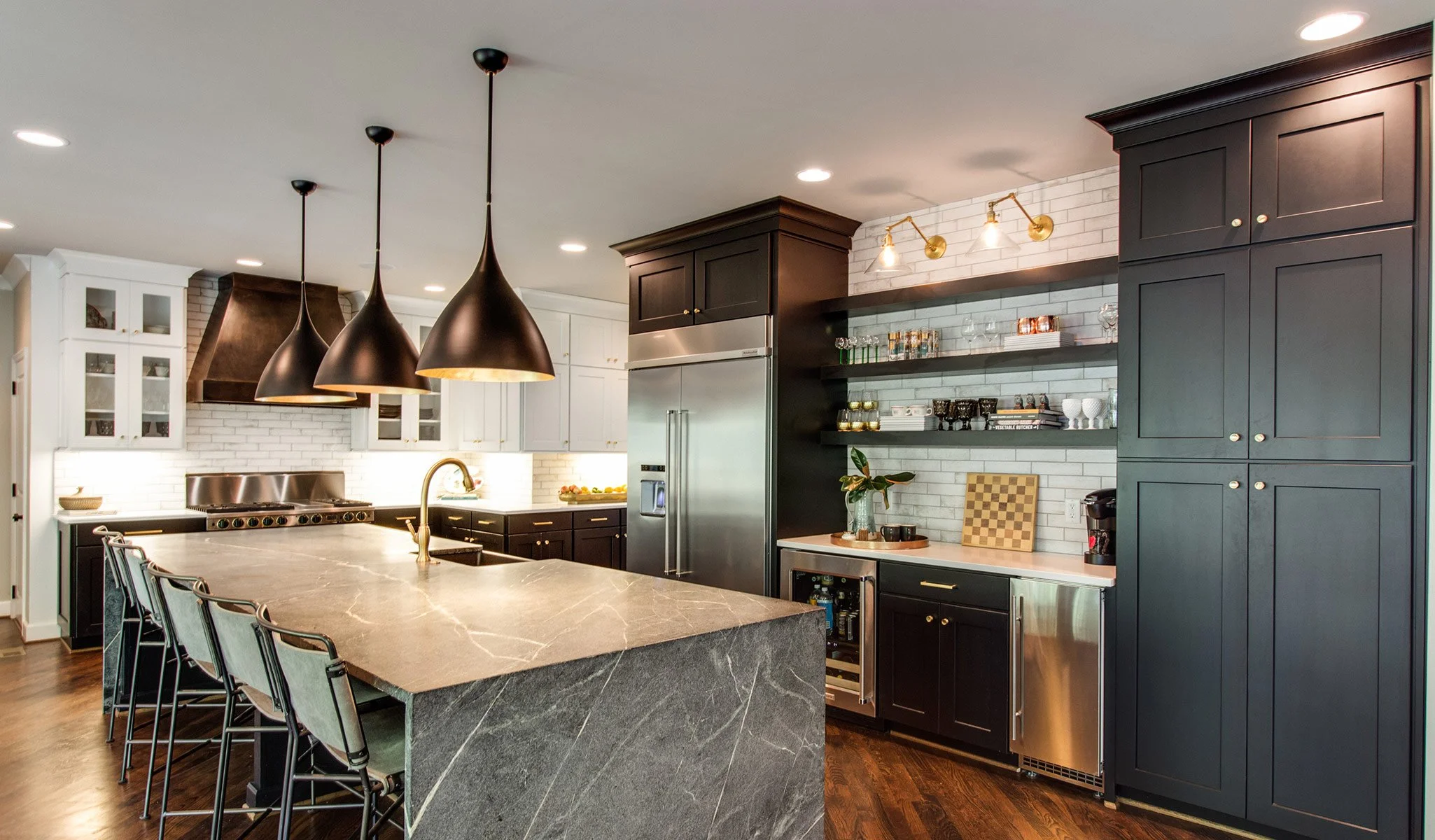Mixing Materials: The Key to Achieving a Multi-Dimensional Kitchen
Mixing materials in kitchen design adds the perfect amount of dimension, depth, and character to your space.
Adding depth with materials may seem overwhelming — after all, there are countless ways this can be achieved. However, with the proper knowledge about what pairs well and how that works for your personal design goals, multi-dimensional kitchen design just got a little easier.
Our West Palm Beach kitchen design company dives into multi-dimensional kitchen design and how it contributes to timeless aesthetic appeal.
Image: Kith Kitchens
How Do Mixed Materials Add Dimension to Kitchen Design?
Combining different textures, finishes, and colors add visual interest to a kitchen.
While some amount of cohesion is good, it’s important to mix elements like this together for an enhanced “wow” factor.
Take these examples, for instance:
Wood, stone, and metal materials
Glossy, rough, and matte finishes
Concrete, fabric, and glass materials
See how kitchen texture layering is full of endless options?
Each material listed above reflects light in different ways, creating a stunning layering effect that brings unique style to your kitchen layout. That’s the beauty of embarking on visual depth kitchen design — it’s full of ways to include your own personal taste.
Image: Kith Kitchens
Popular Materials to Mix in Kitchens
There are plenty of materials you can play around with, especially when it comes to wood and metal kitchen design.
The Core Textures
Wood adds both warmth and a natural feel to kitchens, its organic texture enhancing the character of your space. Pairing expertly with wood in kitchens is metal—a sleek, stylish interior design choice.
Stone like marble or quartz brings natural patterning and cohesive solidarity to your kitchen. For example, stone kitchen countertops are both extremely durable and blend well with a variety of interior styles.
Reflective surfaces, like glass, add a sense of openness to your kitchen. Glass kitchen cabinets are a perfect example of this, as they not only showcase your favorite dishes and decor, but they enhance spaciousness.
It’s key to not forget about the power fabric brings to a kitchen.
Consider working in fabrics like:
Rattan
Woven baskets
Linens
These fabrics not only add to the organic feel of your kitchen’s design, but they work to soften the space too.
Curated Kitchen Co. remodel with woven seating
Ensure Cohesive Kitchen Design While Mixing Materials
Like all aspects of interior design, there’s such a thing as overdoing it.
Mixing materials in kitchen design can quickly become too much, taking away from the natural style of your space.
Here’s what we suggest to promote kitchen design harmony:
Cohesive color palettes: A cohesive color palette ensures your kitchen has aesthetic appeal. This can range from choosing the perfect base shade to complementary accent hues.
Limit materials: This plays into the “too much” factor. Excessive materials can clash rather than complement — so keep it to roughly three. A great example is utilizing natural wood, stone, and fabrics together.
Repeat materials: Repetitive, balanced kitchen materials adds to its cohesion. Think of it as a base pattern holding your kitchen’s design together.
Use Neutrals: It’s rare that you can go wrong with neutrals. This color family helps anchor the visuals of your kitchen and cuts down on a busy appearance.
Image: Wood Harbor
Examples of Mixed Materials in Kitchen Design
The beauty of multi-dimensional kitchen design is its versatility.
Whatever your preferences may be — from traditional to modern kitchen design and anything in between — there’s a way to successfully mix materials. Many of these material combinations are great for those searching for luxury kitchen design ideas, as they expertly blend together for a stunning result.
Take a look at these modern kitchen material combinations:
Classic traditional: For a fresh take on traditional interiors, opt for white oak cabinets, brass hardware, and smooth marble countertops.
Sleek contemporary: Introduce chic, modern style into your home with matte black metal shelving, concrete islands, and natural wood flooring.
Charming rustic: Bring unique character straight into your kitchen with glass-front cabinetry, rattan lighting, and a shining quartz backsplash.
Image: Kith Kitchens
Avoid These Mistakes When Mixing Materials
While multi-dimensional kitchen design adds character to your space, there are a few key mistakes to avoid. Below, we’ll review a handful of classic mixing material pitfalls.
Mistake #1: Cohesion, Not Competition
Cohesion is what you’re looking for in multi-dimensional kitchen design, not competition. Stay away from competing finishes, as this detracts from the overall style of your kitchen and can overwhelm the eye. Instead, stick with one or two finishes throughout.
Mistake #2: Chaos V. Balance
A classic kitchen design mistake is clashing colors. Choosing colors or materials that clash rather than complement tends to create a chaotic, unbalanced feel in kitchens. For instance, a perfect example of clashing colors/materials would be combining warm wood and colder, stark metal features.
Mistake #3: Lack of Functional Durability
Looks aren’t everything in kitchen design. Opting for style over functional is another major kitchen design mistake, and can lead to another remodel sooner than you planned. Since kitchens are often the most high-traffic area of any home, it’s key to choose materials that both match your style preference and offer durability.
Multi-Dimensional Kitchen Design With Your Style In Mind
At Curated Kitchen Co., we understand the principles of multi-dimensional spaces and how that plays into your entire home’s style. Our team of custom kitchen design experts can work with you to create a space for you that prioritizes both style and function.
Contact us today for a kitchen design consultation.




